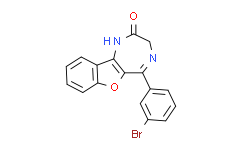| Cas No.: | 768404-03-1 |
| Chemical Name: | 5-BDBD |
| Synonyms: | 5-BDBD;5-(3-Bromophenyl)-1,3-dihydro-2H-benzofuro[3,2-e]-1,4-diazepin-2-one |
| SMILES: | BrC1C=CC=C(C2=NCC(=O)NC3C4C=CC=CC=4OC2=3)C=1 |
| Formula: | C17H11BrN2O2 |
| M.Wt: | 355.185443162918 |
| Purity: | >98% |
| Sotrage: | 2 years -20°C Powder, 2 weeks 4°C in DMSO, 6 months -80°C in DMSO |
| Description: | 5-BDBD, a potent and selective P2X4 receptor antagonist, inhibits rP2X4R-mediated currents, with an IC50 of 0.75 μM. 5-BDBD completely blocks the basal and acute hyperalgesia induced by nitroglycerin (NTG)[1][2]. |
| Target: | I50: 0.75 μM (P2X4 receptor) |
| In Vivo: | 5-BDBD (28 mg/kg; i.p.; daily for 9 days) can completely blocke the basal hyperalgesia induced by recurrent NTG injection[2]. Animal Model: Male C57BL/6 mice[2] Dosage: 28 mg/kg Administration: I.p.; daily for 9 days Result: Prevented NTG-induced mechanical hypersensitivity. |
| In Vitro: | 5-BDBD inhibits 10 µM ATP-induced currents of rP2X4R-expressing HEK293 cells in a concentration-dependent manner, with an IC50 of 0.75 μM[1]. 5-BDBD displaces rightward the ATP concentration-response curve, with an EC50 of 4.7 to 15.9 μM[1]. 5-BDBD could be specifically used to discriminate between P2X1R, P2X2aR, P2X2bR, P2X3R, P2X4R, and P2X7R[1]. |
| References: | [1]. Coddou C, et al. Characterization of the antagonist actions of 5-BDBD at the rat P2X4 receptor. Neurosci Lett. 2019;690:219-224. [2]. Long T, et al. Microglia P2X4 receptor contributes to central sensitization following recurrent nitroglycerin stimulation. J Neuroinflammation. 2018;15(1):245. Published 2018 Aug 30. |

 To enhance service speed and avoid tariff delays, we've opened a US warehouse. All US orders ship directly from our US facility.
To enhance service speed and avoid tariff delays, we've opened a US warehouse. All US orders ship directly from our US facility.




















